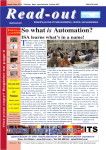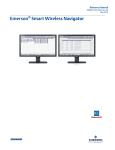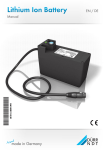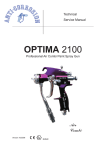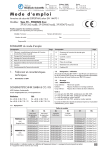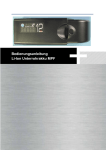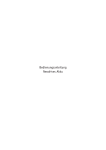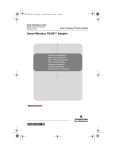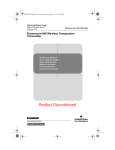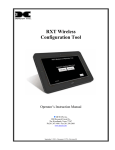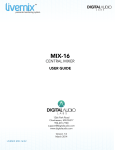Download Emerson Process Management Wireless Gateway 1420 User's Manual
Transcript
1420_QIG_Rev_CA.fm Page 1 Thursday, June 7, 2007 1:18 PM Quick Installation Guide 00825-0100-4420, Rev CA June 2007 1420 Wireless Gateway 1420 Wireless Gateway Start Step 1: Initial Connection for Configuration Step 2: Basic Security and Time Configuration Step 3: Basic Ethernet or Serial Configuration Step 4: Mount and Connect the 1420 End ¢00825-0100-4420[¤ 1420_QIG_Rev_CA.fm Page 2 Thursday, June 7, 2007 1:18 PM Quick Installation Guide 00825-0100-4420, Rev CA June 2007 1420 Wireless Gateway © 2007 Rosemount Inc. All rights reserved. All marks property of owner. Emerson Process Management Rosemount Temperature GmbH Emerson Process Management Frankenstrasse 21 Rosemount Division Asia Pacific Private Limited 8200 Market Boulevard Chanhassen, MN USA 55317 T (US) (800) 999-9307 T (Intnl) (952) 906-8888 F (952) 949-7001 63791 Karlstein Germany T 49 (6188) 992 0 F 49 (6188) 992 112 1 Pandan Crescent Singapore 128461 T (65) 6777 8211 F (65) 6777 0947 / (65) 6777 0743 [email protected] IMPORTANT NOTICE This installation guide provides basic guidelines for the 1420 Wireless Gateway. It does not provide instructions for detailed configuration, diagnostics, maintenance, service, troubleshooting, or installations. Refer to the 1420 Wireless Gateway reference manual (document number 00809-0100-4420) for more instruction. The manual and this QIG are also available electronically on www.rosemount.com. WARNING Explosions could result in death or serious injury: Installation of this device in an explosive environment must be in accordance with the appropriate local, national, and international standards, codes, and practices. Please review the Hazardous Locations Certifications for any restrictions associated with a safe installation. Electrical shock can result in death or serious injury • Avoid contact with the leads and terminals. High voltage that may be present on leads can cause electrical shock. WARNING Explosion Hazard Do not disconnect equipment when a flammable or combustible atmosphere is present. IMPORTANT NOTICE The 1420 Wireless Gateway should be installed before installing any other wireless devices. This will result in a simpler and faster network installation. Physical Device Revision 1.0 Web Server Revision 3.0.8 Network Revision 1.0 2 1420_QIG_Rev_CA.fm Page 3 Thursday, June 7, 2007 1:18 PM Quick Installation Guide 00825-0100-4420, Rev CA June 2007 1420 Wireless Gateway STEP 1: INITIAL CONNECTION FOR CONFIGURATION To configure the 1420 Wireless Gateway, a local connection between a PC/laptop and the 1420 Wireless Gateway must be established. NOTE: If a PC/laptop from another network is used, carefully record the current IP address and other settings so the PC/laptop can be returned to its original network when configuration of the 1420 is finished. Perform the following steps to establish a local connection with the 1420 Wireless Gateway: 1. On the PC/laptop, install the Java Plug-in found on the CD provided with the 1420. The Plug-in can also be found at http://java.com/ 2. Under Network Connections: a. Select Local Area Connection b. Right click to select Properties. 3 1420_QIG_Rev_CA.fm Page 4 Thursday, June 7, 2007 1:18 PM Quick Installation Guide 1420 Wireless Gateway 00825-0100-4420, Rev CA June 2007 c. Select Internet Protocol (TCP/IP), then click the Properties button d. Select the Use the following IP address button and set the IP address to 192.168.1.12 e. Set the Subnet Mask to 255.255.255.0 f. Select OK for each of the settings windows that have opened. 3. Using the supplied crossover Ethernet cable, attach your PC/laptop to the 1420’s P1 Ethernet Receptacle (far right Ethernet receptacle). PC/Laptop P1 Ethernet Receptacle 24 V DC Power Input + - Modbus S S A Not Used B + Not Used - S S - S S - + - + Case + POE P2 P1 Not Used Not Used (Covered) Crossover Cable WARNING Do not connect to the P3 Power Over Ethernet (POE) port. This port supplies power and could potentially damage the PC/laptop. 4 1420_QIG_Rev_CA.fm Page 5 Thursday, June 7, 2007 1:18 PM Quick Installation Guide 00825-0100-4420, Rev CA June 2007 1420 Wireless Gateway 4. Open a standard web browser (Internet Explorer, Mozilla Firefox or similar). 5. Uncheck proxies (Tools>Internet Options>Connections>LAN Settings) 6. Access the 1420’s default web page at https://192.168.1.10 a. Log on as User: admin b. Password: default 5 1420_QIG_Rev_CA.fm Page 6 Thursday, June 7, 2007 1:18 PM Quick Installation Guide 1420 Wireless Gateway c. Click Yes to proceed through the Security Alert The 1420 Home Page will appear as shown below 6 00825-0100-4420, Rev CA June 2007 1420_QIG_Rev_CA.fm Page 7 Thursday, June 7, 2007 1:18 PM Quick Installation Guide 00825-0100-4420, Rev CA June 2007 1420 Wireless Gateway STEP 2: BASIC SECURITY AND TIME CONFIGURATION To configure the basic security of the 1420 Wireless Gateway, perform the following steps. 1. Navigate to Setup>Security>User Accounts 2. Set and confirm new passwords for each of the access levels 3. Click Submit 4. Navigate to Setup>Time 5. Select method and click Submit 7 1420_QIG_Rev_CA.fm Page 8 Thursday, June 7, 2007 1:18 PM Quick Installation Guide 1420 Wireless Gateway 00825-0100-4420, Rev CA June 2007 STEP 3: BASIC ETHERNET OR SERIAL CONFIGURATION To configure the 1420 for an Ethernet Network: Table 2: Ethernet Communication Settings on page 15 is available to assist in recording the necessary information. 1. Determine 1420 Ethernet Port for connecting to Ethernet Network If using a wired connection, use Port 1 (P1) IT/Process Control Network Administrator or Technician can provide the following: a. 1420 fixed IP Address or DHCP Host Name b. Netmask (Subnet Mask) c. Gateway BEST PRACTICE: Keep these values in a secure location not accessible by unauthorized personnel. 2. Configure 1420 Ethernet IP settings a. Access the 1420 with Administrator access b. Navigate to Setup>Internet Protocol>Address c. Enter configuration information determined above 3. To complete configuration without a firewall, click Submit and proceed with 1420 Restart when prompted. 8 1420_QIG_Rev_CA.fm Page 9 Thursday, June 7, 2007 1:18 PM Quick Installation Guide 00825-0100-4420, Rev CA June 2007 1420 Wireless Gateway STEP 3 CONTINUED... To configure the 1420 for a Serial connection: Table 4: Serial Communication Settings on page 15 is available to assist in recording the necessary information. 1. Configure 1420 Serial Communication Settings a. Access the 1420 Web Interface with Administrator access b. Navigate to Setup>Modbus>Communication c. Click Enable Modbus d. Configure the 1420 Modbus Communication settings to match the Host Modbus settings NOTE: Modbus communications will fail if they are not configured identically on the Host and the 1420. e. Click Submit and proceed with restart 2. When configuration is completed, disconnect the PC/laptop from the 1420 and return the PC/laptop to its previous network settings. 9 1420_QIG_Rev_CA.fm Page 10 Thursday, June 7, 2007 1:18 PM Quick Installation Guide 1420 Wireless Gateway 00825-0100-4420, Rev CA June 2007 STEP 4: MOUNT AND CONNECT THE 1420 Integral Antenna with the 1420 on a Mast The optimal installation of the 1420 Wireless Gateway is on a pole approximately 1.8 meters above the top of the exterior wall of a building. The following hardware and tools are needed: • Pipe mount with holes spaced 3.06 inches (78 mm) apart horizontally and 11.15 inches (283 mm) apart vertically. • Two 3.06 inch (78 mm) by 5/16 inch U-bolts • 1/2 inch wrench Mount the gateway by doing the following: 1. Insert one U-bolt around the pipe and through the top mounting holes of the pipe mount and the 1420, and another U-bolt through the bottom mounting holes of the pipe mount and the 1420. 2. Using a 1/2 inch socket-head wrench, fasten the nuts to the U-bolts and tighten. BEST PRACTICE When mounting outside, best practice is to run the Serial or primary Ethernet cable (P1) directly to the Information System. Use conduit and/or strain relief as necessary. BEST PRACTICE When installing cable/conduit, run an ethernet connection from 1420 port P2 to a convenient location indoors (if the 1420 was ordered with Output Code 2). This will simplify future configuration changes. 10 1.8 m (6 ft.) Strain Relief 1420_QIG_Rev_CA.fm Page 11 Thursday, June 7, 2007 1:18 PM Quick Installation Guide 00825-0100-4420, Rev CA June 2007 1420 Wireless Gateway STEP 4 CONTINUED... Connect to Information System 1. Wire the 1420 Primary Ethernet output or Serial Output connection to the Host System Ethernet or Serial input connections. 2. For Serial connections, connect A to A, B to B and make sure all terminations are clean and secured to avoid wiring connection problems. Figure 1. 1420 Terminal Block Diagram Serial Modbus 24 V DC Power Input + - S A B Not Used + Not Used - S S - S S - + - + Case + POE (Covered) P2 (Secondary) P1 (Primary) Not Used Not Used BEST PRACTICE Typically, twisted shielded pair cable is used to wire the Serial connection. Standard practice is to ground the shield on the Serial Host side and leave the shield floating on the 1420 side. Be sure to insulate the 1420 shield to avoid grounding issues. NOTE: In most systems, A = Tx + and B = Rx -. In some systems, this is reversed. For 4-wire systems, see Figure 2. Figure 2. Typical Full Duplex (4-wire) to Half Duplex (2-wire) Conversion Diagram Tx + Tx + = (A) Rx + Tx Rx - = (B) Rx Confirm wiring configuration with host system documentation. Supply Power After mounting is complete supply power to the 1420 according to the following steps: 1. Ground the 1420 using suitable grounding methods. There is a case ground lug located near the terminal block, and an external ground lug located near the conduit entries on the bottom of the housing. 2. Connect the 24 V DC power wiring to the Power Input terminals in the 1420. The 1420 requires 500 mA of current. (see Terminal and Integration Diagram on page 14) 3. Close the terminal cover and tighten securely. BEST PRACTICE Use an uninterruptible power supply (UPS) to ensure that the network is still functional should there be a loss of power. 11 1420_QIG_Rev_CA.fm Page 12 Thursday, June 7, 2007 1:18 PM Quick Installation Guide 1420 Wireless Gateway 00825-0100-4420, Rev CA June 2007 PRODUCT CERTIFICATIONS Approved Manufacturing Locations Rosemount Inc. – Chanhassen, Minnesota, USA Telecommunication Compliance All wireless devices require certification to ensure that they adhere to regulations regarding the use of the RF spectrum. Nearly every country requires this type of product certification. Emerson is working with governmental agencies around the world to supply fully compliant products and remove the risk of violating country directives or laws governing wireless device usage. To see which countries our devices have received certification for use in, see www.rosemount.com/smartwireless. European Union Directive Information The EC declaration of conformity for all applicable European directives for this product can be found on the Rosemount website at www.rosemount.com. A hard copy may be obtained by contacting your local sales representative. ATEX Directive (94/9/EC) Emerson Process Management complies with the ATEX Directive. Electro Magnetic Compatibility (EMC) (2004/108/EC) EN 61326-1: 1997 with amendments A1, A2, and A3– Industrial Radio and Telecommunications Terminal Equipment Directive (R&TTE)(1999/S/EC) Emerson Process Management complies with the R&TTE Directive FM Ordinary Locations Approval The 1420 Wireless Gateway has been evaluated and approved by FM for ordinary locations. CE EMC Marking Compliance with European Union EMC Hazardous Location Certifications North American Certifications N5 FM Division 2 Certificate Number: See Certificate Nonincendive for Class I, Division 2, Groups A,B,C, and D; Dust Ignitionproof for Class II,III, Division 1, Groups E,F, and G; Indoor/outdoor locations; NEMA Type 4X Temperature Code: T4 (-40°C < Ta < 60°C) 12 1420_QIG_Rev_CA.fm Page 13 Thursday, June 7, 2007 1:18 PM Quick Installation Guide 00825-0100-4420, Rev CA June 2007 1420 Wireless Gateway Canadian Standards Association (CSA) N6 CSA Division 2 & Dust Ignitionproof Certificate Number: See Certificate Suitable for Class I, Division 2, Groups A,B,C,D; Dust Ignitionproof for Class II, Groups E,F, and G; Suitable for Class III Hazardous Locations. Install per Rosemount drawing 01420-1011. Temperature Code: T4 (-40°C < Ta < 60°C) CSA Enclosure Type 4XEuropean Certification European Certification N1 CENELEC Type n (ATEX) See note below Certificate Number: See Certificate ATEX Marking: Ex II 3 G EEx nA nL IIC T4 (-40°C < Ta < 60°C) ND ATEX Dust Ignition-proof Approval Certificate Number: See Certificate Ex tD A22 IP66 T135 (-40 °C< Ta < +60 EEx nA nL IIC T4 (-40°C < Ta < 60°C) Vmax = 28V II 3D IECEx Certification N7 IECEx Type n See note below Certificate Number: See Certificate Ex nC IIC T4 (-40°C =< Ta <= +60°C) Rated Voltage: 28V NF IECEx Dust Ignition-proof Approval Certificate Number: See Certificate Ex tD A22 IP66 T135 (-40°C < Ta < 60°C) Vmax = 28V CONDITIONS OF INSTALLING N1 AND N7: The Apparatus is not capable of withstanding the 500V insulation test required by Clause 9.4 of EN 60079-15: 2005. This must be taken into account when installing the apparatus. 13 14 Local 1420 HMI (Covered) POE S P2 (Secondary) - AMS P1 (Primary) A B Modbus - - Not Used OPC Application + + Not Used S S Not Used - - Not Used Modbus TCP S S DCS / PLC + + DCS/PLC HMI 1420 Wireless Gateway Remote 1420 HMI For P2 and POE connectivity options, see the 1420 Wireless Gateway Manual, document number 00809-0100-4420. Case + 24 V DC Power Input Serial Serial Input Card 1420_QIG_Rev_CA.fm Page 14 Thursday, June 7, 2007 1:18 PM Quick Installation Guide 00825-0100-4420, Rev CA June 2007 Figure 3. Terminal and Integration Diagram 1420_QIG_Rev_CA.fm Page 15 Thursday, June 7, 2007 1:18 PM Quick Installation Guide 00825-0100-4420, Rev CA June 2007 1420 Wireless Gateway Table 1. Ethernet Port Locations Settings Location 1420 Ethernet Port P1 Information System Switch or Access Point Switch or Access Point Ethernet Port Table 2. Ethernet Communication Settings Setting Value Options Use Fixed IP or DHCP? Fixed IP Address or DHCP Host Name Netmask (Subnet Mask) Gateway Fixed or DHCP XXX.XXX.XXX.XXX or XXXXXXX YYY.YYY.YYY.YYY ZZZ.ZZZ.ZZZ.ZZZ Table 3. Serial Connectivity Locations Locations Serial Card Location Serial Card ID Serial Card Termination A (Tx +) Serial Card Termination B (Rx -) Table 4. Serial Communication Settings Setting Value Modbus Slave Address Baud Rate Parity Stop Bits Response Delay Time Unmapped Register Read Response Unmapped Register Write Response Write Behavior Floating Point Representation Use Swapped Floating Point Format Incorporate Value’s Associated Status as Error? Value Reported for Error *Other* Value Reported for Error Options on 1420 (Default in Bold) 1 - 247 9600, 19200, 38400, 57600 None, Even, Odd 1, 2 0 ms, Configurable in ms Zero, Illegal Data OK, Illegal Data Address Synchronous, Queued, Most Current Float, Round (Integer), Scale Yes, No Yes, No NaN, +Inf, -Inf, *Other* 32767, (Any Integer) 15 1420_QIG_Rev_CA.fm Page 16 Thursday, June 7, 2007 1:18 PM Quick Installation Guide 1420 Wireless Gateway 16 00825-0100-4420, Rev CA June 2007
















